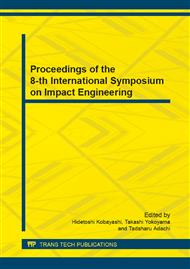[1]
A. William and Jr. Gooch: 2011 overview of the development of ceramic armor technology: past, present qnd the future, Advances in Ceramic Armor VII: Ceramic Engineering and Science Proceedings, J.J. Swab et al (Eds), (2011), pp.195-214.
DOI: 10.1002/9781118095256.ch18
Google Scholar
[2]
Z. Rosenberg, S.J. Bless, Y. Yeshurun and K. Okajima: A new definition of ballistic efficiency of brittle materials based on the use of thick backing plates, in Proc of IMPACT 87 symposium, impact loading and dynamic behavior of materials, C.Y. Chiem and et al. eds., (1987).
Google Scholar
[3]
MIL-STD-376A, Ballistic performance ranking of ceramic armour plates against high density penetrators, Department of Defense Test Method Standard. (1998).
Google Scholar
[4]
T.J. Holmquist, A.M. Rajendran, D.W. Templeton and K.D. Bishnoi: A ceramic armour materials database, TARDEC technical report No. 13754. (1999).
Google Scholar
[5]
A. Tate: A theory for the deceleration of long rods after impact, J. Mech. Phys. Solids. 15 (1967), p.387–399.
Google Scholar
[6]
V.P. Alekseevskii: Penetration of a rod into a target at high velocity, Combustion Explosion Shock Waves. 2 (1966), p.63–66.
DOI: 10.1007/bf00749237
Google Scholar
[7]
C.E. Anderson and J.D. Walker: An examination of long rod penetration, Int. J. Impact Eng. 11 (1991), p.481–501.
Google Scholar
[8]
Z. Rosenberg and J. Tsaliah: Applying Tate's model for the interaction of long-rod projectiles with ceramic targets, Int. J. Impact Eng. 9 (1990), p.247–251.
DOI: 10.1016/0734-743x(90)90016-o
Google Scholar
[9]
J. Buchar and J. Hrebicek: Modeling penetration phenomena: Solving problems in scientific computing using Maple and Matlab, W. Gander and et al. Eds., (2004), pp.203-218.
DOI: 10.1007/978-3-642-97953-8_15
Google Scholar
[10]
W. Walters and C. Williams: A solution of the Alekseevski-Tate penetration equations, ARL-TR-3606. (2005).
DOI: 10.21236/ada443657
Google Scholar
[11]
V. Hohler, A.J. Stilp and K. Weber: Penetration of tungsten-alloy rods into alumina, Int. J. Impact Eng. 17 (1995), p.409–418.
DOI: 10.1016/0734-743x(95)99866-p
Google Scholar
[12]
Z. Rosenberg and E. Dekel: Further examination of long rod penetration: the role of penetrator strength at hypervelocity impacts, Int. J. Impact Eng. 24 (2000), p.85–101.
DOI: 10.1016/s0734-743x(99)00032-9
Google Scholar
[13]
C.E. Anderson and S.A. Royal Timmons: Ballistic performance of confined 99. 5% Al2O3 ceramic tiles, Int. J. Impact Eng. 19 (1997), pp.703-713.
DOI: 10.1016/s0734-743x(97)00006-7
Google Scholar
[14]
Z. Rosenberg and E. Dekel: A numerical study of the cavity expansion process and its application to long-rod penetration mechanics, Int. J. Impact Eng. 35 (2008), p.147–154.
DOI: 10.1016/j.ijimpeng.2007.01.005
Google Scholar


